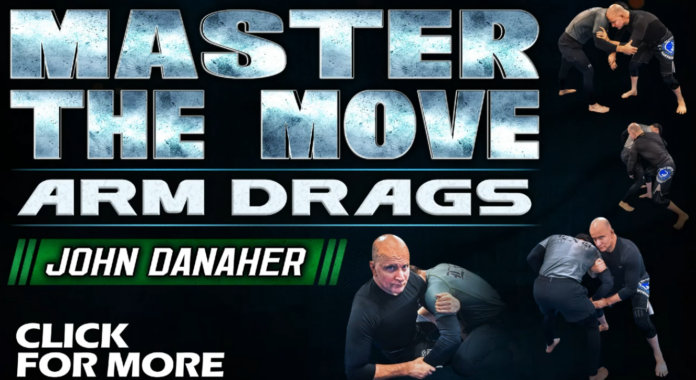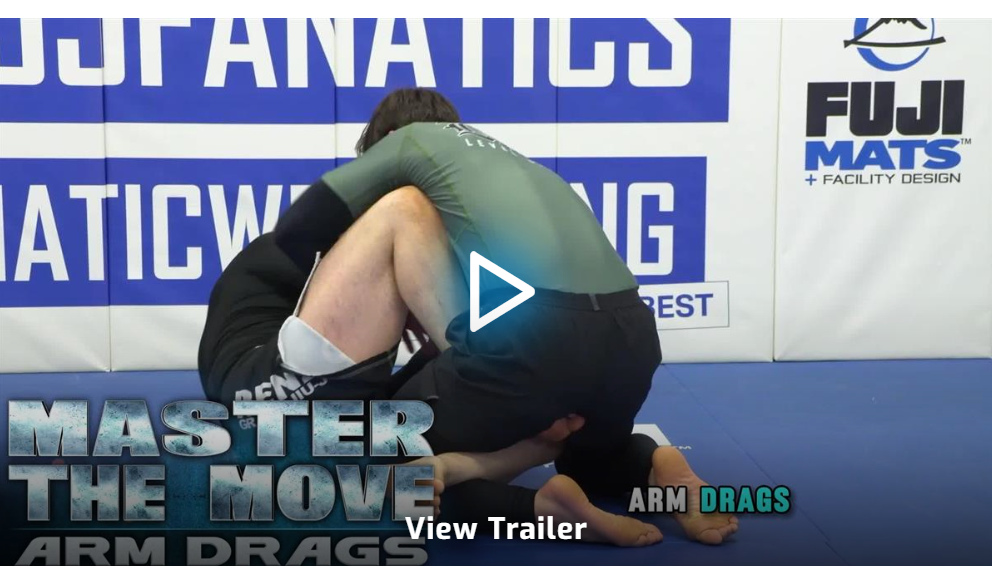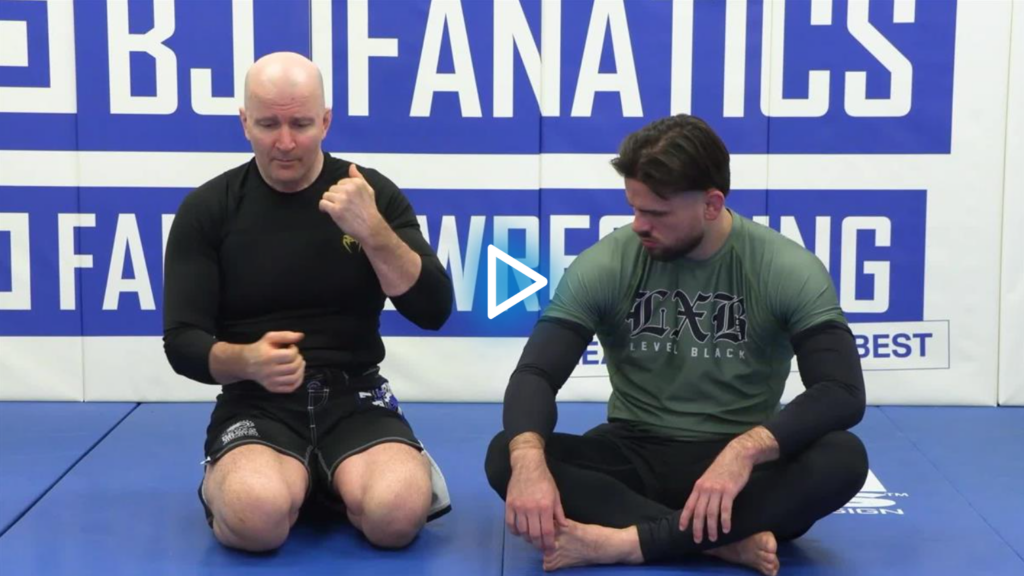
We’re taking a look today at the John Danaher Arm Drags DVD, a part of his new Master The Move series. The subject is a move that is extremely potent in grappling but often falls short of its potential on account of several key mechanical oversights.
Throughout 8 volumes of this No-Gi instructional, John attempts to solve all problems commonly encountered with the arm drag and offers a complete system to help you excel with it. Standing or in guard, attacking or defending, you’ll find use of the arm drag, so it is about time that you do everything you can to master it.
Key Takeaways
- An 8-part No-Gi BJJ DVD with over 5 hours of material on arm drags.
- Covers seated and supine guards, standing and defensive uses of arm drags.
- Each volume is a mini-system of its own that you can use to improve specific areas of your BJJ game.
- BJJ World Expert Rating: 10 out of 10.
JOHN DANAHER ARM DRAGS DVD AVAILABLE HERE!!!

A Staple of Grappling – The Arm Drag
The arm drag is a wrestling move that has been around as long as grappling. At some point, somebody, somewhere figured out that if you drag a person’s arm across their chest (or yours) you end up with a very dominant position to control their movement.
Nowadays, arm drag is everywhere, from Jiu-Jitsu to MMA, and represents a high-percentage move that allows you to completely isolate one side of the opponent’s body. The issue with it is that people tend to mess up two very important parts of the arm drag’s mechanics.
First of all, everyone thinks an arm drag is done using your arms. That is wrong. The arms are simply a means to connect to the opponent’s arm. Once you’re attached you use your entire body to execute the actual drag and achieve superior positioning.
Secondly, most people in BJJ grab the inside of the elbow when they’re pulling. In wrestling, they go for the shoulder so when you aim to place your grip inside the opponent’s armpit you’re going to get a much more powerful and effective arm drag.
For those interested in learning more about how to use this wrestling staple in modern Jiu-Jitsu, there’s no better resource than the Master The Move: John Danaher Arm Drags DVD.
The Man Who Changed Everything
Almost 15 years ago, when I first started training BJJ, the name John Danaher was not a staple of the BJJ World like it is now. I first heard of him from GSP, when one of the best P4P MMA fighters ever brought John to his Ultimate Fighter coaching team.
Fast forward a few years and in the early 2010s obscure grapplers started to dominate the then very young professional Jiu-Jitsu scene by using leg locks, a Boogeyman technique nobody cared for until that point. That is when John Danaher entered the spotlight, as the mastermind behind the system that shocked the grappling community.
As a grappler, Danaher is a rare example of how far someone can influence combat sports in general by only focusing on coaching others. Never a competitor himself, due to a myriad of reasons, mostly injuries, the eccentric genius showed everyone why Renzo more or less left him in charge of his famous blue basement for decades.
Danaher’s five minutes have turned into years, and at this point, he keeps on contributing to the betterment of the grappling world. His latest effort, the John Danaher Arm Drags DVD is an instructional aiming to demystify and organize the way in which we use one of the oldest grappling techniques in the context of our sport.
Master The Move: John Danaher Arm Drags DVD Review
The Master The Move John Danaher Arm Drags DVD is a BJJ instructional featuring 8 volumes of detailed instructions on how to integrate the arm drag into your grappling game. it addresses seated, supine, and standing situations, covering both offense and defense.
The material is presented in No-Gi but has a direct carry-over to Gi grappling. The total length of the full l8-volume DVD is around 5 hours. Here is what you can find inside:
Part 1 – The 10 Principles of Arm Drags
The entire opening volume of this John Danaher Arm Drags DVD targets the principles and basic mechanics that make armbars work. John spends an hour looking at the key considerations behind arm drags in BJJ and organizing the foundational principles behind the move.
Danaher’s system is based on simultaneously looking at follow-ups to classic armbars, thinking about lower body connections, dragging directions, stance, attacking both arms, grip control, head placement, etc. Exactly what you’d expect from a John Danaher instructional.
Part 2 – Seated Arm Drags
The reason people gravitate towards arm drags in BJJ so much, albeit mostly ineffectively, is that they work perfectly when you’re playing guard. Which guard? Well, as it turns out in this instructional, most, if not all of them.
The first guarded scenario in which John explores the use of arm drags is the seated guard. Danaherexplores ways in which you can use the arm drag both when rising and when you’re pulling the opponent down. A lot of your efforts to master the move depend on creating Kuzishi, or off-balance.
The first half explores different armbar techniques that create Kuzushi as part of the setup. The second position focuses on the opponent’s reactions, and how to turn them to an advantage by transitioning to other moves, such as the double leg, snapdowns, or leg entanglements.
Part 3 – The Supine Guard Arm Drag System
Volume three goes all the way to the mats, exploring supine guards and their relationship with the arm drag. The butterfly guard, one of John’s favorites, plays a major role here, but BJJ staples such as the Reverse De la Riva and the seated guard also feature.
Similarly to the previous volume of the John Danaher Arm Drags DVD, after exploring the mechanics Dnahaer launches into common scenarios. These include arm drags that lead to slides, trip attacks, and more wrestling-based leg takedowns, like the ankle pick.
Part 4 – Dragging Arms from Butterfly Guard
Nearing the halfway point of the instructional, John’s focus shifts solely to the butterfly guard, and its next-door neighbor, the half butterfly (a.k.a. butter-half) guard. This is a shorter volume compared to the others, given the highly specific subject.
The central problem addressed here is the high hand issue, which dictates how you grip and when you can arm drag. John offers ways to mitigate this, opening up a bunch of sweeps, including the dreaded should crunch.
Part 5 – Defensive Arm Drags
An aspect of arm drags you probably haven’t thought of before is using them for defensive purposes. Of course, Danaher knows all about it and shares it in the fifth volume of this John Danaher Arm Drags DVD.
The focus is on a position John dubbs ‘the double pits position’ which opens up the opportunity to enforce defense by using arm drags. Danaher also covers front headlock arm drags here, as well as some main principles of wrestling up to arm drags.
Part 6 – Arm Drags On the Feet
Since the previous volume got us to the feet, Danaher switches gears and starts looking at how you can Master The Move for standing exchanges. As with anything involving standing, grips play a crucial role, which in the case of arm drags, has everything to do with wrist control.
This volume is a mixture of Judo and wrestling that is typical for Danaher, with lots of Japanese terms thrown in there. The bottom line is that you need to use your legs and entire body to make arm drags work from standing, as looking to only drag with your arms is not enough to create Kuzushi.
Part 7 – Inside Tie Arm Drag
Nearing the end of the John Danaher Arm Drags DVD, we’re looking at more focused aspects of the standing arm drags game. First up is the inside tie position, perhaps the most effective grip vs. standing opponents in all grappling martial arts.
John connects this with an open stance entry, which results in different wrist and elbow-level drags, as well as the option to switch from one of the opponent’s arms to the other. In this volume, Danaher also talks a lot about how head positioning affects the outcome of armed drags.
Part 8 – Knee Drop Arm Drags
As this Danaher instructional comes to an end, John offers a last bit of arm-dragging brilliance by talking about knee drops. While most people in BJJ avoid these, they are unavoidable and heavily used in both Judo and wrestling.
the final part of the DVD addresses double and single knee drops, and how you can use them to attack either side of your opponent. Towards the end, Danaher shares some underhooking options as an alternative to the inside tie he favors.
Creating Back Exposure
While an arm drag is no guarantee that you’ll get to someone’s back, simply creating the exposure is a massive advantage during grappling. The arm drag allows you to isolate one side of the opponent’s body and force them into predictable motions which you can easily capitalize on using many different follow-ups.
The key thing that happens during an arm drag is that you break the opponent’s posture, by forcing them to twist their spine. If they resist this, that means a free one-way ticket to the back for you. When they try to pull out, the twist in the spine takes away a key foundation of grappling – their posture and allows you to set up really much whatever you want.
once you’ve got someone’s posture under your control, whether you’re standing or playing guard, you can proceed to make them fall. How do you do that? Find a way to use the attachment you have (arm drag) to make them touch the mats with the free arm. Once that happens you’re good to go.
Takedowns, sweeps, submissions, and transitions to leg locks or the back, all become a possibility once you have the opponent’s posture and balance broken. a lot of this is covered in great detail inside the John Danaher Arm Drags DVD.

FULL DOWNLOAD: JOHN DANAHER ARM DRAGS DVD
Drag That Arm Across!
You’ve used arm drags, and you’ll be using arm drags, whether you want it or not. They’re just too good an opportunity to miss out on. Why not arm yourself with deep knowledge on these subjects, so you can actually be effective with them and not just use them to break up grip engagements?
This Master The Move: John Danaher Arm Drags DVD is one of his best instructionals to date, with lots of the fluff taken out nothing but highly useful information presented in 5 hours. If nothing else, the volume on the defensive use of the arm drag is worth getting the instructional alone.


![Darce Choke Encyclopedia – Origins, Mechanics and Variations [2025] BJJ, choke, Brabo, BJJ Darce Choke, D'arce Choke, Darce BJJ Choke](https://bjj-world.com/wp-content/uploads/2017/11/JungPoirierLeeYahoo-218x150.jpg)









![Get Off My Legs Gringo Craig Jones DVD Review [2025] Get Off My Legs Gringo Craig Jones DVD Review](https://bjj-world.com/wp-content/uploads/2025/03/get-off-my-legs-gringo-craig-jones-dvd-review-218x150.png)
![Leg Lock Entries Helena Crevar DVD Review [2025] Leg Lock Entries Helena Crevar DVD Review](https://bjj-world.com/wp-content/uploads/2025/03/leg-lock-entries-helena-crevar-dvd-review-218x150.png)
![Special K Guard Neil Melanson DVD Review [2025] Special K Guard Neil Melanson DVD Review](https://bjj-world.com/wp-content/uploads/2025/03/special-k-guard-neil-melanson-dvd-review-218x150.png)
![Arm Bar It All Shawn Melanson DVD Review [2025] Arm Bar It All Shawn Melanson DVD Review](https://bjj-world.com/wp-content/uploads/2025/03/arm-bar-it-all-shawn-melanson-dvd-review-218x150.png)
![Advantage Over Time Outside Passing Jozef Chen DVD Review [2025] Advantage Over Time Outside Passing Jozef Chen DVD Review](https://bjj-world.com/wp-content/uploads/2025/03/outside-passing-jozef-chen-dvd-review-218x150.png)
![Guard Busters Bill Cooper BJJ DVD Review [2025] Guard Busters Bill Cooper BJJ DVD Review](https://bjj-world.com/wp-content/uploads/2025/03/guard-busters-bill-cooper-bjj-dvd-review-218x150.png)
![Full Guard Formula James Booth DVD Review [2025] Full Guard Formula James Booth DVD Review](https://bjj-world.com/wp-content/uploads/2025/02/full-guard-formula-james-booth-dvd-review-324x235.png)
![Shoulder Lock Mastery Zach Green DVD Review [2025] Shoulder Lock Mastery Zach Green DVD Review](https://bjj-world.com/wp-content/uploads/2024/12/shoulder-lock-mastery-zach-green-dvd-review-100x70.png)


![Efficiently Executing X-Guard Giancarlo Bodoni DVD Review [2024] Efficiently Executing X-Guard Giancarlo Bodoni DVD Review](https://bjj-world.com/wp-content/uploads/2024/09/efficiently-executing-x-guard-giancarlo-bodoni-dvd-REVIEW-100x70.png)
![Edging Yourself Out Of Danger Craig Jones DVD Review [2024] Edging Yourself Out Of Danger Craig Jones DVD Review](https://bjj-world.com/wp-content/uploads/2024/12/edging-yourself-out-of-danger-craig-jones-dvd-review-100x70.png)


![Back Control and Submission Felipe Pena DVD Reveiw [2025] Back Control and Submission Felipe Pena DVD Reveiw](https://bjj-world.com/wp-content/uploads/2025/01/back-control-and-submission-felipe-pena-dvd-reveiw-100x70.png)

![Back Hacks Yigit Haney BJJ DVD Review [2025] Back Hacks Yigit Haney BJJ DVD Review](https://bjj-world.com/wp-content/uploads/2024/12/back-hacks-yigit-haney-bjj-dvd-review-100x70.png)

![Just Pass Jay Rodriguez DVD Review [2024] Just Pass Jay Rodriguez DVD Review](https://bjj-world.com/wp-content/uploads/2024/11/just-pass-jay-rodriguez-dvd-review-100x70.png)
![Jeff Higgs Self Defense Guard BJJ DVD Review [2024] Jeff Higgs Self Defense Guard BJJ DVD Review](https://bjj-world.com/wp-content/uploads/2024/09/jeff-higgs-self-defense-guard-bjj-dvd-review-100x70.png)


![Osoto Gari for Jiu Jitsu Jackson Nagai DVD Review [2024] Osoto Gari for Jiu Jitsu Jackson Nagai DVD Review](https://bjj-world.com/wp-content/uploads/2024/10/osoto-gari-for-jiu-jitsu-jackson-nagai-dvd-review-100x70.png)

![Grappling Takedown Dominance Brandon Ruiz DVD Review [2025] Grappling Takedown Dominance Brandon Ruiz DVD Review](https://bjj-world.com/wp-content/uploads/2025/01/grappling-takedown-dominance-brandon-ruiz-dvd-review-100x70.png)

![Reverse Arm Bar System Andrew Kerfoot DVD Review [2024] Reverse Arm Bar System Andrew Kerfoot DVD Review](https://bjj-world.com/wp-content/uploads/2024/10/reverse-arm-bar-system-andrew-kerfoot-dvd-review-100x70.png)
![Arm Bar It All Shawn Melanson DVD Review [2025] Arm Bar It All Shawn Melanson DVD Review](https://bjj-world.com/wp-content/uploads/2025/03/arm-bar-it-all-shawn-melanson-dvd-review-100x70.png)
![Closed Guard Reintroduced Adam Wardzinski DVD Review [2025] Closed Guard Reintroduced Adam Wardzinski DVD Review](https://bjj-world.com/wp-content/uploads/2025/01/closed-guard-reintroduced-adam-wardzinski-dvd-review-100x70.png)


![Leg Lock Entries Helena Crevar DVD Review [2025] Leg Lock Entries Helena Crevar DVD Review](https://bjj-world.com/wp-content/uploads/2025/03/leg-lock-entries-helena-crevar-dvd-review-100x70.png)

![Jeff Glover DVD Bundle Review: Chokin’ Around With Uncle Jeff [2024] Jeff Glover DVD Bundle Review: Chokin' Around With Uncle Jeff](https://bjj-world.com/wp-content/uploads/2024/10/jeff-glover-dvd-bundle-review-chokin-around-100x70.png)
![Dynamic Headquarters Passing Jason Rau DVD Review [2024] Dynamic Headquarters Passing Jason Rau DVD Review](https://bjj-world.com/wp-content/uploads/2024/10/dynamic-headquarters-passing-jason-rau-dvd-review-100x70.png)
